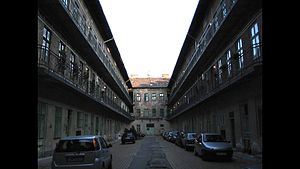This article needs additional citations for verification. (May 2010) |

The pillarbox effect occurs in widescreen video displays when black bars (mattes or masking) are placed on the sides of the image. It becomes necessary when film or video that was not originally designed for widescreen is shown on a widescreen display, or a narrower widescreen image is displayed within a wider aspect ratio, such as a 16:9 image in a 2.39:1 frame (common in cinemas). The original material is shrunk and placed in the middle of the widescreen frame.
Some older arcade games that had a tall vertical and short horizontal are displayed in pillarbox even on 4:3 televisions. Some early sound films made between 1928 and 1931, such as Sunrise: A Song of Two Humans, were released in even narrower formats such as 1.20:1 to make room for the sound-on-film track on then-standard film stock.[1] These will appear pillarboxed even on 4:3 screens.
Pillarboxing is the vertical equivalent of (horizontal) letterboxing and goes by several names, including reverse letterboxing, curtain boxing, or postcarding. Pillarboxing is derived from its resemblance to pillar box–style mailboxes used in the UK and the Commonwealth of Nations. The four-direction equivalent is called windowboxing, caused when programming is both letterboxed and pillarboxed.
In order to use the entire screen area of a widescreen display (which is already significantly less than a fullscreen of equal diagonal measurement), and to prevent a reverse screen burn-in on plasma displays, the simplest alternative to pillarboxing is to crop the top and bottom. However, this results in the loss of some of the image within what the producer assumed would be the safe area. This overscan may or may not bother the viewer, but it often cuts off the channel banner or other on-screen displays. Likewise, the vertical equivalent of pan and scan is called "tilt and scan" or "reverse pan and scan". This moves the cropped "window" up and down, but it is rarely done. A third option is to stretch the video to fill the screen, but this is often considered ugly, as it severely distorts everything on the screen.
Because certain screen resolutions can be used for both fullscreen and widescreen (anamorphic), widescreen signaling (such as the Active Format Description) must be used to tell the display device which to use, or the viewer must set it manually, in order to prevent unnecessary pillarboxing or stretching on widescreen displays.